巻き寿司とおにぎりの違いと特徴
Differences and characteristics between sushi rolls and onigiri
当店は巻き寿司専門店ですが、おにぎり専門店はたくさんあり、浅草にも美味しいおにぎり専門店が多数あります。そこで改めて、違いと特徴についてまとめてみました。
日本の食文化を代表するものとして、巻き寿司とおにぎりがあります。どちらも米を主材料とし、手軽に食べられる点で共通していますが、その形状や作り方、食べ方に違いがあります。この記事では、おにぎりと巻き寿司の違いと特徴について書いてみました。
巻き寿司の特徴
- 形状と種類
巻き寿司は、海苔を使って酢飯と具材を巻き込んだもので、細巻き、太巻き、裏巻き(カリフォルニアロールなど)、手巻き寿司などの種類があります。具材としては魚介類、野菜、卵焼き、かんぴょうなどが使われます。 - 歴史と由来
巻き寿司の起源は江戸時代にさかのぼります。江戸前寿司の一種として登場し、当時は手軽なファストフードとして親しまれていました。関東地方では「細巻き」、関西地方では「太巻き」や「恵方巻き」としても有名です。 - 作り方
巻き寿司は、巻き簾(まきす)を使って作ります。まず、海苔を敷き、その上に酢飯を広げます。酢飯の上に具材を乗せ、巻き簾を使ってきれいに巻き込んでいきます。巻き方や具材の配置により、見た目や味わいが変わるため、技術と工夫が求められます。
おにぎりの特徴
- 形状と種類
おにぎりは、その名の通り「握る」ことで作られる三角形、俵形、丸形などの形が一般的です。中には具材を包み込むものや、具材を混ぜ込む「混ぜおにぎり」もあります。具材としては梅干し、鮭、昆布、ツナマヨネーズなどが定番です。 - 歴史と由来
おにぎりの歴史は古く、平安時代には「強飯(こわめし)」として存在していました。戦国時代には兵士の携行食としても利用され、その手軽さと保存性の良さから現代でも人気の食べ物となっています。 - 作り方
おにぎりは炊いたご飯を手で握って作ります。ラップを使って握ることもありますが、手で直接握ると塩加減や握り具合が調整しやすいです。具材を中心に包むようにご飯を握り、最後に海苔を巻くことが一般的です。
巻き寿司とおにぎりの違い
形状と見た目:巻き寿司は円筒形や円錐形で、巻いて切った形が特徴的。おにぎりは主に三角形や俵形で、握った形が特徴的。
材料と味付け:巻き寿司は酢飯を使用し、具材を海苔とともに巻き込む。おにぎりは炊いたご飯に塩を少々加えて握り、具材を包み込む。
作り方:巻き寿司は巻き簾を使って巻く。おにぎりは手で握る。
用途とシーン:おにぎりは携行食として手軽に食べられる。
巻き寿司は見た目の美しさが重視され、宴会や特別な食事に適している。
まとめ
巻き寿司とおにぎりは、どちらも日本の食文化を代表する存在です。その違いを理解することで、より一層日本の食文化の深さと多様性を感じることができます。日常の食事として楽しむもよし、特別な場での一品として楽しむもよし、ぜひ巻き寿司とおにぎりの両方を楽しんでみてください。
Our shop specializes in rolled sushi, but there are many shops specializing in onigiri, and Asakusa also has many shops specializing in delicious onigiri. So, once again, we summarized the differences and characteristics.
Sushi rolls and rice balls are representative of Japanese food culture. Both have rice as their main ingredient and are easy to eat, but there are differences in their shape, how they are made, and how they are eaten. In this article, I wrote about the differences and characteristics between onigiri and sushi rolls.
Characteristics of sushi rolls
shape and type
Sushi rolls are made by wrapping vinegared rice and other ingredients in nori seaweed, and come in various types such as thin rolls, thick rolls, ura rolls (such as California rolls), and hand rolls. The ingredients used include seafood, vegetables, omelet, and kanpyo.
History and origin
The origin of sushi rolls dates back to the Edo period. It first appeared as a type of Edomae sushi and was popular as a convenient fast food at the time. It is also famous as “hosomaki” in the Kanto region, and “futomaki” or “ehomaki” in the Kansai region.
How to make
Sushi rolls are made using makisu. First, spread the seaweed and spread the vinegared rice on top. Place the ingredients on top of the vinegared rice and roll them neatly using a makisu. The appearance and taste change depending on how you roll it and the placement of ingredients, so skill and ingenuity are required.
Characteristics of rice balls
shape and type
As the name suggests, onigiri are generally shaped like triangles, straw bags, or circles, which are made by “gripping”. There are some types of rice balls that wrap around ingredients, and there are also “mixed rice balls” that have ingredients mixed in. Typical ingredients include pickled plums, salmon, kelp, and tuna mayonnaise.
History and origin
Onigiri has a long history and existed as “kowameshi” during the Heian period. During the Warring States period, it was used as a carry-on food for soldiers, and it remains a popular food today due to its convenience and long shelf life.
How to make
Onigiri are made by holding cooked rice in your hands. Sometimes I use plastic wrap to squeeze it, but it’s easier to adjust the amount of salt and grip if you squeeze it directly with your hands. It is common to wrap rice around the ingredients, and then wrap it in seaweed at the end.
Difference between sushi rolls and onigiri
Shape and Appearance: Sushi rolls are cylindrical or conical in shape, and are characterized by their rolled and cut shape. Onigiri are mainly triangular or straw-shaped, with their distinctive shape being that they are squeezed.
Ingredients and seasoning: Sushi rolls are made using vinegared rice, and the ingredients are rolled in seaweed. Onigiri are made by adding a little salt to cooked rice, making rice balls, and wrapping the ingredients around them.
How to make: Roll the sushi using a makisu. Hold the rice ball with your hands.
Uses and Occasions: Onigiri can be easily eaten as a portable meal.
The beauty of sushi rolls is important, making them suitable for banquets and special meals.
summary
Sushi rolls and rice balls are both representative of Japanese food culture. By understanding these differences, you will be able to appreciate the depth and diversity of Japanese food culture even more. Enjoy both sushi rolls and rice balls, whether you enjoy them as a daily meal or as a dish for special occasions.



